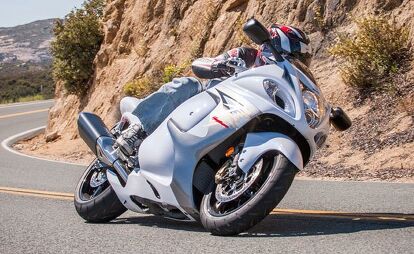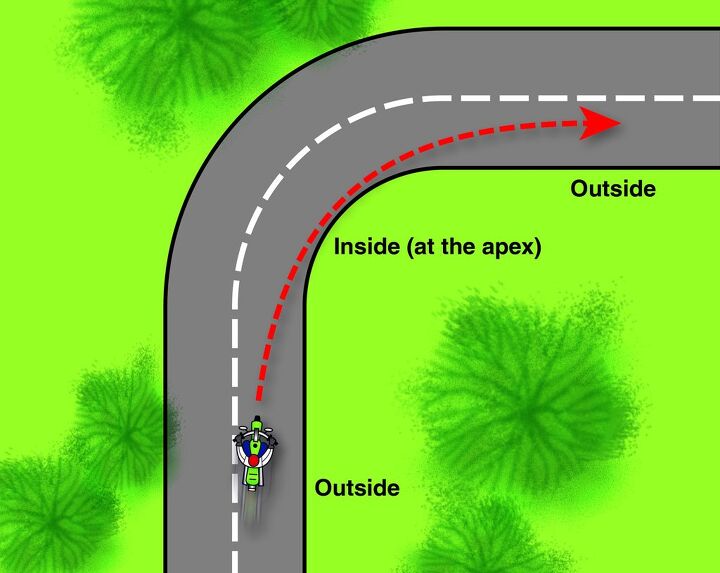How To Negotiate Decreasing-Radius Corners

Helping you to prepare for the unexpected
Updated January 2020
Perhaps no corners strike greater fear in the hearts of motorcyclists than decreasing-radius corners. What’s a decreasing-radius corner, you ask? There are essentially three general types of corners we encounter as riders. A constant radius-corner maintains the same arc throughout the entire turn. These are the most predictable corners on the road. Even if you can’t see the exit, you can tell from the entrance exactly what speed is safe to navigate the corner all the way to the exit. An increasing-radius corner is one in which the bend gets less sharp the further into it you ride. In this type of corner, you can start rolling on the throttle much earlier because the corner is getting straighter. A decreasing-radius corner, then, would be one in which the corner gets sharper as you progress into it. So, what may have been a safe speed in the initial section of the curve could be too fast as the corner tightens up.
However, the corners themselves aren’t really the cause for the concern. It’s really the surprise of entering an unfamiliar corner, setting your speed and your line, only to suddenly have the rules change midway. Remember that, despite the surprise, if your bike isn’t dragging hard parts, you have the ground clearance to lean the bike over even more — probably more than you think.
Before we discuss the challenge of decreasing-radius corners, we should quickly review an easy one. This will make sure we have the same techniques in mind. In an idealized constant-radius corner, the rider can see from entry to exit. So, the bike’s approach would be wide at the entrance with the appropriate speed set before the turn-in point.
A rider should look through the corner, initiate the turn, and begin rolling on the throttle. Rolling on the throttle settles the suspension and keeps the bike from falling into the corner as the bike heads towards the apex. After the apex, acceleration can increase as the bike begins to stand up, putting a larger footprint on the pavement and following its line to the outside of its lane at the exit of the corner.
If the entire corner could be seen at the entry, the tightening of a radius could be planned for from the beginning — just like with our idealized corner. So, in order to address the fear of the decreasing radius, we should look at the proper way through the corner and then backtrack to see how we can apply this knowledge to corner entry — even when we don’t know a decreasing radius lies ahead.
Motorcycle Cornering Clearance – What To Do When It Runs Out
If you’re taking the classic line through a corner and the radius tightens — even just a little — it will have the same effect as early apexing a corner: The bike will run wide at the exit. So, when approaching a decreasing-radius corner, the best tactic for a street rider would be to set the entry speed for the tighter portion of the curve, hold a wide line at the entrance of the corner, and dial in more lean angle until the line heads towards the apex of the tightened radius.
Newer riders will want to set a slower speed at the actual corner entry. For more advanced riders, trail braking through the initial corner to the tighter section can be utilized as long as you’re cognizant that traction for braking is reduced by cornering forces. Smooth application of the brakes is paramount, as an abrupt spike in brake pressure — or abruptly chopping the throttle — can cause traction loss and send you tumbling.
While traction for braking in a corner is limited, entering the corner trailing the brakes and having the bike’s weight shifted on to the front end actually helps with steering input. The fork’s rake angle decreases as it compresses, making the bike respond more quickly to steering input. You have also compressed the tire, giving it a larger contact patch and more traction.
However, the harder you’re cornering, the thinner the line is between having enough grip to brake while leaned over and a low-side crash. Once initiating your line in the tighter section of the corner, begin accelerating for the exit as you normally would.
In the example above, we assumed we could see the entire corner and, therefore, could plan accordingly. However, on the street, you will frequently enter corners where you can’t see the exit. While you can draw clues for where the corner goes from trees or telephone poles or fence lines, these can be misleading. (Have you ever been following a row of telephone poles for miles only to see them go straight off into a field while the road makes a turn?)
Proper Motorcycle Lane Positioning
So, when riding on an unfamiliar road, you should always hold a minimum of 20 percent of your skillset, traction, and ground clearance in reserve for the unexpected — which could come in the form of a tightening radius, an obstacle, liquid, a bicyclist, or any other of the myriad of things you might encounter in the real world.
The prudent street rider will set road speed based on the radius of the corner at its entry (while keeping that 20 percent reserve) but will still maintain a wide line. Once the corner’s exit is spotted, the final line, which clips the apex, can be selected. A wide line gives the maximum view of the road ahead, increasing the time to react to the unexpected. Even while holding the wide line, you can accelerate through the corner to settle the suspension as you normally would. If a corner begins to tighten up, you have that reserved cornering clearance to dip in to.
If you suspect the changing radius will ask for more ground clearance than you have, you can modify your speed — or prevent it from increasing — by lightly applying the rear brake and maintaining a neutral throttle. If the corner requires that you slow even more, roll off the throttle — do not chop it — and smoothly apply the brakes. When practicing this technique, notice how, when you decelerate while leaned over, your line will naturally tighten, aiding in achieving your desired path through the corner. After you’ve set your new line, treat the corner’s exit just like every other corner.
One other tactic for solving the decreasing-radius corner dilemma should be mentioned, although it applies more to the track or roads with which you are familiar. When you know a corner has a decreasing radius before you enter it, double apexing a turn essentially turns one corner into two, with each being dealt with separately. However, we’ll discuss this technique in a future article.
Motorcycle Downshifting Techniques
Decreasing-radius corners are just another part of the enjoyable challenge of riding motorcycles. If you practice these techniques, you’ll have them to draw on in an instant when a blind curve becomes more challenging than it initially looked.

Like most of the best happenings in his life, Evans stumbled into his motojournalism career. While on his way to a planned life in academia, he applied for a job at a motorcycle magazine, thinking he’d get the opportunity to write some freelance articles. Instead, he was offered a full-time job in which he discovered he could actually get paid to ride other people’s motorcycles – and he’s never looked back. Over the 25 years he’s been in the motorcycle industry, Evans has written two books, 101 Sportbike Performance Projects and How to Modify Your Metric Cruiser, and has ridden just about every production motorcycle manufactured. Evans has a deep love of motorcycles and believes they are a force for good in the world.
More by Evans Brasfield






































Comments
Join the conversation
Do highway engineers design decreasing radius curves only around mountains where they can't avoid it or do they build them on flat land just for fun? One of the most famous in the U.S. connects the Long Island Expressway with the Cross Island - there's a scene in "The French Connection" where Popeye Doyle is standing by that curve after a wreck.
Corebikerz is one of the top Indian Atotmotive Company. You can Buy Bike Accessories and Spare Parts online from here.